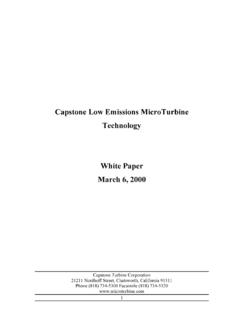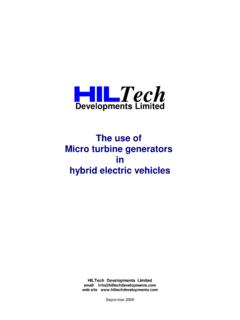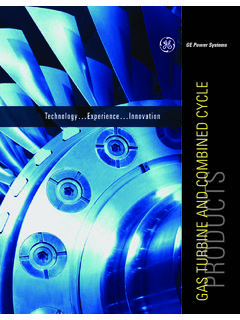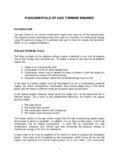Transcription of Mini- and micro-gas turbines for combined heat and power q
1 Mini- and micro -gas turbines for combined heat and Pilavachi*Research Directorate-General, European Commission, 200 Rue de la Loi, 1049 Brussels, BelgiumReceived 15 March 2002 ;accepted 25 August 2002 AbstractThe use of mainframe gas turbines for power generation has increased in recent years and is likely tocontinue to increase. The proportion of power generation using combined heat and power is also growingmainly due to efficiency improvements and environmental and micro - turbines offer a number of potential advantages compared to other technologies forsmall-scale power generation, particularly for distributed power generation, although there are sometechnical and non-technical barriers to the implementation of the technology. There is an uncertainty abouttheir market potential but they could be used for power generation in the industrial, commercial andresidential sectors. The market potential could increase substantially if the cost, efficiency, durability, re-liability, and environmental emissions of the existing designs are improved.
2 2002 European Communities. Published by Elsevier Science Ltd. All rights : Mini- turbines ; micro - turbines ; combined heat and power ;Distributed generation ;Market potential ofmicro-turbines1. IntroductionAll forecasts of future world energy supply anticipate an increase across the globe. The pro-jection of the POLES, business as usual, model [1] shows almost a doubling of the world primaryenergy supply between 2000 and 2020 (Fig. 1) in agreement with other models (IEA, World Bank,etc.). Electricity demand is projected to increase by the same order of magnitude over the sameperiod (Fig. 2). The emissions of CO2are likely to increase by at least the same amount becauseApplied Thermal Engineering 22 (2002) 2003 content of this article does not necessarily reflect the official position of the European Commission and theCommission is not responsible for the use which might be made of this information. The views expressed here are thoseof the author and do not necessarily reflect those of the European Commission.
3 *Tel.: +32-2-295-3667 ;fax: + Pilavachi).1359-4311/02/$ - see front matter 2002 European Communities. Published by Elsevier Science Ltd. All rights : S1359-4311(02)00132-1advanced technology introduced into developed countries network will be offset by increased useof fossil fuels for transport as well as lower cost and lower efficiency plants in developingcountries. micro - turbines for combined heat and power may contribute to reductions of CO2emissions depending on the way in which the sector develops. In this paper, I would define micro - turbines to range up to 150 kWe while Mini- turbines to range from 150 kWe up to 1 MWe. Thereis no standard definition and each author defines these ranges more or less world wide dependence on fossil fuels is still likely to be around 90% in 2020 unless majormeasures are taken to introduce renewable energies into the system. Oil, coal and natural gas willhave the largest share of energy supply.
4 Nuclear electricity will remain relatively stable andrenewables will 2. World electricity generation (EC, POLES model).Fig. 1. World primary energy supply (EC, POLES model). Pilavachi / Applied Thermal Engineering 22 (2002) 2003 2014 The major increase in fuel for power generation in industrialised countries is foreseen to in-creasingly become natural gas. The European Union s electricity generation from natural gas hastripled in the last 10 these scenarios, major attempts will have to be made if CO2emissions are not to increaseand countries take steps to meet the targets they committed to at the Kyoto Conference in largest increase in the use of natural gas for power generation will principally be accom-modated by the continuing introduction of gas turbine plant in simple cycle, complex cycle andcombined cycle has a substantial stake in the gas turbine market with manufacturers producing ma-chines with ratings from less than 1 MWe (mini- and micro - turbines ), up to the biggest gas turbinecombined cycles, which produce over 400 MWe on a single shaft.
5 For the purposes of this paper,both mini- and micro - turbines will henceforth be referred to as the increasing use of natural gas as a fuel, the output of gas turbines for power generationare projected to increase from around 570 GW in 1999 to 2035 GW in 2020 ;an increase of over6%/yr. The value of this market is around 20 bn Euro/yr. The increase of power demand will bemet by large combined cycle turbine (CCGT) plant (up to 400 MW), but with a growing im-portance in distributed power applications in the 30 150 MW addition, micro - turbines in combined heat and power (CHP) applications may take an in-creasing share of this market. The trend towards deregulation of the electricity supply market willinfluence the speed of the potential introduction of what has become known as distributedgeneration [2]. Distributed generation is a revolutionary concept, which consists of local gen-eration of electric, thermal or mechanical technologies are used in distributed generation including gas turbines , reciprocatingengines, fuel cells, solar systems and wind turbines .
6 There is a particular interest in the potential oftechnologies such as micro - turbines and reciprocating engines. However, for micro - turbines andother distributed energy resources to be competitive in power markets, the price of electricityproduction will need to be more attractive than today. Without cost reductions, most electricityusers will prefer grid-connected power and energy-efficient distributed energy resources will beconfined to a relatively small market Advantages and disadvantages of micro - turbines and combined heat and powerMicro- turbines offer a number of potential advantages compared to other technologies forsmall-scale power generation [3]. For example, compact size and low-weight per unit powerleading to reduced civil engineering costs, a small number of moving parts, lower noise, multi-fuelcapabilities as well as opportunities for lower emissions (in the CHP context).
7 In addition, gas turbines enjoy certain merits relative to diesel engines in the context of Mini- and micro - power generation. They have high-grade waste heat , low maintenance cost, low vi-bration level and short delivery absence of reciprocating and friction components means that balancing problems are few,and the use of lubricating oil is very low. In the lower power ranges reciprocating engines havehigher efficiencies, but these are now being challenged by gas turbine power plant derived Pilavachi / Applied Thermal Engineering 22 (2002) 2003 20142005high-efficiency aero-engines and the increasing efficiency of industrial gas turbines , particularlywhen they are used in the CHP options other than natural gas include diesel, landfill gas, industrial off-gases, ethanol, andother bio-based liquids and technical barriers to the implementation of micro - turbine technology are that, at present,the gas turbine has a lower efficiency in its basic configuration than an equal power output re-ciprocating engine.
8 In addition, the efficiency of the gas turbine decreases at partial load andburning of lower heating value fuels may not be feasible, depending on the type of the turbine . Inaddition, electricity distribution systems are generally unsuitable for the installation of a largenumber of small plants and they require modification, the costs of which have to be taken intoaccount. Also, micro - turbine plant, require power conditioning to produce electricity at gridfrequency and this brings further additional costs to an non-technical barriers to the implementation of gas turbine technology are that main-tenance requires more skilled personnel than does the reciprocating engine and that small gasturbines are expensive compared to reciprocating engines. Grid connection standards are also anon-technical non-technical barriers to the implementation of CHP systems are that the investmentpayback period could be high (up to six years), the costs of grid connection might be high, theaccess to the electricity network for reasonably price services is not always possible ( exportpower, back-up power and top-up power ), access to the gas network is not always possible andthere are still administrative and institutional barriers to CHP in several countries.
9 In addition,CHP technology and its benefits are not widely known, there is possibility of increasing localpollution and there is the requirement of a close matching of electric and heat The market for micro -turbinesMicro- turbines could be used for power generation in the industrial, commercial and residentialsectors but there is an uncertainty about their market could be used for: continuous power generation ;premium power ;peak shaving ;emergencystandby ;remote power ; combined heat and power ;mechanical drive ;and wastes and that have the greatest estimated market potential for micro - turbines include chem-icals, food and drink, pulp and paper, and textiles. Remote power applications are for off-gridlocations such as oil, gas and mining operations. The market for wastes and bio-mass burningmicro- turbines are found in those industries that produce solid, liquid, or gaseous fuels as a wasteor by-product such as pulp and paper and food , the largest use for micro - turbines could be in combined heat and power systems.
10 Theexhaust heat from a gas turbine is of high quality high temperature, and can be used toproduce heat for industrial processes or space heating (CHP). For micro - turbines to get the highefficiencies, the exhaust gas is passed through a recuperator to increase the electrical efficiency andtherefore the final heat grade available is of lower quality (temperature). In CHP applications, gasturbine plants can reach an overall efficiency exceeding 80%. However, for micro - turbines andother distributed energy resources to be competitive in power markets, the price of electricityproduction will need to be more attractive than Pilavachi / Applied Thermal Engineering 22 (2002) 2003 2014 But, there are also other obstacles to the market development potential of gas fired micro - turbines [4]. micro - turbines must not only compete with centralised power stations using lessexpensive fuels and having high efficiencies, but must also face the continuous technical progressof large-scale gas-fired combined cycles as well as of the other gas-fired prime movers alreadypresent in the combined heat and power market.










